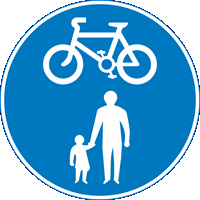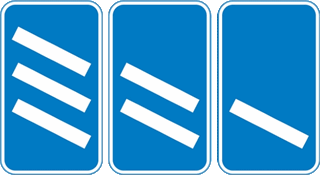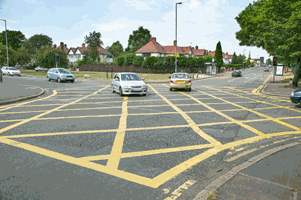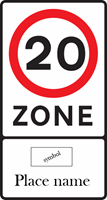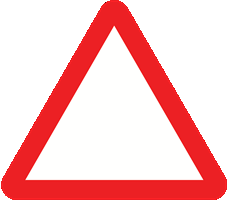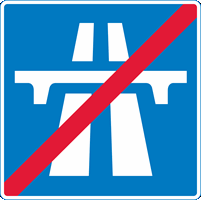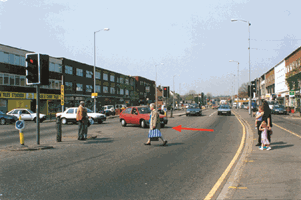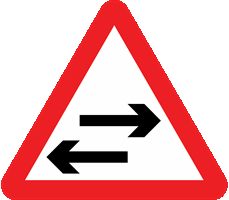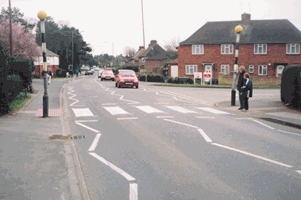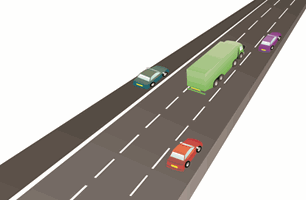You have 57 minutes to answer 50 multiple choice driving theory test questions. You need to answer at least 43 out of 50 questions correctly to pass. You can review your answer after each question or you can review all of your answers at the end of the test. Best of luck!
Test Quick View
Click on an answer to view the correct choice along with the explanation.
Correct Answer: A
Explanation: Your tyres are your only contact with the road. To prevent problems with braking and steering, keep your tyres free from defects; they must have sufficient tread depth and be correctly inflated. Correct tyre pressures help reduce the risk of skidding and provide a safer and more comfortable drive or ride.
Explanation: Your tyres are your only contact with the road. To prevent problems with braking and steering, keep your tyres free from defects; they must have sufficient tread depth and be correctly inflated. Correct tyre pressures help reduce the risk of skidding and provide a safer and more comfortable drive or ride.
Correct Answer: B
Explanation: Inconsiderate parking can obstruct the flow of traffic and so make traffic congestion worse. Red routes are designed to prevent this by enforcing strict parking restrictions. Driving slowly in traffic increases fuel consumption and causes a build-up of exhaust fumes.
Explanation: Inconsiderate parking can obstruct the flow of traffic and so make traffic congestion worse. Red routes are designed to prevent this by enforcing strict parking restrictions. Driving slowly in traffic increases fuel consumption and causes a build-up of exhaust fumes.
Correct Answer: B
Explanation: This sign shows a shared route for pedestrians and cyclists: when it ends, the cyclists will be rejoining the main road.
Explanation: This sign shows a shared route for pedestrians and cyclists: when it ends, the cyclists will be rejoining the main road.
4. You're coming up to a roundabout. A cyclist is signalling to turn right. What should you do? Mark one answer
AB
C
D
Correct Answer: B
Explanation: If you're following a cyclist who's signalling to turn right at a roundabout, leave plenty of room. Give them space and time to get into the correct lane.
Explanation: If you're following a cyclist who's signalling to turn right at a roundabout, leave plenty of room. Give them space and time to get into the correct lane.
Correct Answer: C
Explanation: The exit from a motorway is indicated by countdown markers. These are positioned 90 metres (100 yards) apart, the first being 270 metres (300 yards) from the start of the slip road. Move into the left-hand lane well before you reach the start of the slip road.
Explanation: The exit from a motorway is indicated by countdown markers. These are positioned 90 metres (100 yards) apart, the first being 270 metres (300 yards) from the start of the slip road. Move into the left-hand lane well before you reach the start of the slip road.
A
B
C
D
B
C
D
Correct Answer: D
Explanation: There's a 30 mph speed limit where there are street lights unless signs show another limit.
Explanation: There's a 30 mph speed limit where there are street lights unless signs show another limit.
Correct Answer: A
Explanation: Clearways are in place so that traffic can flow without the obstruction of parked vehicles. Just one parked vehicle can cause an obstruction for all other traffic. You mustn't stop where a clearway is in force, not even to pick up or set down passengers.
Explanation: Clearways are in place so that traffic can flow without the obstruction of parked vehicles. Just one parked vehicle can cause an obstruction for all other traffic. You mustn't stop where a clearway is in force, not even to pick up or set down passengers.
Correct Answer: D
Explanation: Yellow box junctions are marked on the road to prevent the road becoming blocked. Don't enter the box unless your exit road is clear. You may wait in the box if you want to turn right and your exit road is clear but oncoming traffic or other vehicles waiting to turn right are preventing you from making the turn.
Explanation: Yellow box junctions are marked on the road to prevent the road becoming blocked. Don't enter the box unless your exit road is clear. You may wait in the box if you want to turn right and your exit road is clear but oncoming traffic or other vehicles waiting to turn right are preventing you from making the turn.
Correct Answer: B
Explanation: If you're in a place where there are likely to be pedestrians (for example, outside a school, near a park, in a residential area or in a shopping area), you should be cautious and keep your speed down. Many local authorities have taken steps to slow traffic down by creating traffic-calming measures such as speed humps. They're there for a reason; slow down.
Explanation: If you're in a place where there are likely to be pedestrians (for example, outside a school, near a park, in a residential area or in a shopping area), you should be cautious and keep your speed down. Many local authorities have taken steps to slow traffic down by creating traffic-calming measures such as speed humps. They're there for a reason; slow down.
Correct Answer: D
Explanation: This type of sign warns you of hazards ahead. Make sure you look at each sign that you pass on the road, so that you don't miss any vital instructions or information.
Explanation: This type of sign warns you of hazards ahead. Make sure you look at each sign that you pass on the road, so that you don't miss any vital instructions or information.
11. At this junction, there's a 'stop' sign and a solid white line on the road surface. Why is there a 'stop' sign here? Mark one answer
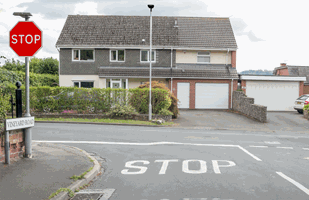
B
C
D
Correct Answer: D
Explanation: If your view at a road junction is restricted, you must stop. There may also be a 'stop' sign. Don't emerge until you're sure no traffic is approaching. If you don't know, don't go.
Explanation: If your view at a road junction is restricted, you must stop. There may also be a 'stop' sign. Don't emerge until you're sure no traffic is approaching. If you don't know, don't go.
Correct Answer: A
Explanation: You must obey signals given by the police. If a police officer in a patrol vehicle wants you to pull over, they'll indicate this without causing danger to you or other traffic.
Explanation: You must obey signals given by the police. If a police officer in a patrol vehicle wants you to pull over, they'll indicate this without causing danger to you or other traffic.
Correct Answer: A
Explanation: On the motorway, signs sometimes show temporary warnings due to traffic or weather conditions. They may be used to indicate
- lane closures
- temporary speed limits
- weather warnings
Explanation: On the motorway, signs sometimes show temporary warnings due to traffic or weather conditions. They may be used to indicate
- lane closures
- temporary speed limits
- weather warnings
Correct Answer: B
Explanation: When you leave the motorway, make sure that you check your speedometer. You may be going faster than you realise. Slow down and look for speed-limit signs.
Explanation: When you leave the motorway, make sure that you check your speedometer. You may be going faster than you realise. Slow down and look for speed-limit signs.
Correct Answer: C
Explanation: Traffic-calming measures make the roads safer for vulnerable road users, such as cyclists, pedestrians and children. These can be designed as chicanes, road humps or other obstacles that encourage drivers and riders to slow down.
Explanation: Traffic-calming measures make the roads safer for vulnerable road users, such as cyclists, pedestrians and children. These can be designed as chicanes, road humps or other obstacles that encourage drivers and riders to slow down.
Correct Answer: A
Explanation: The markings are there to show that the area must be kept clear. This is to allow an unrestricted view for
- approaching drivers and riders
- children wanting to cross the road
Explanation: The markings are there to show that the area must be kept clear. This is to allow an unrestricted view for
- approaching drivers and riders
- children wanting to cross the road
17. You're signalling to turn right in busy traffic. How would you confirm your intention safely? Mark one answer
AB
C
D
Correct Answer: B
Explanation: In some situations, you may feel your indicators can't be seen by other road users. If you think you need to make your intention more obvious, give the arm signal shown in The Highway Code.
Explanation: In some situations, you may feel your indicators can't be seen by other road users. If you think you need to make your intention more obvious, give the arm signal shown in The Highway Code.
18. When approaching a right-hand bend, you should keep well to the left. Why is this? Mark one answer
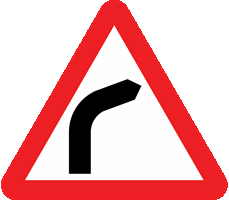
B
C
D
Correct Answer: B
Explanation: Doing this will give you an earlier view around the bend and enable you to see any hazards sooner. It also reduces the risk of collision with an oncoming vehicle that may have drifted over the centre line while taking the bend.
Explanation: Doing this will give you an earlier view around the bend and enable you to see any hazards sooner. It also reduces the risk of collision with an oncoming vehicle that may have drifted over the centre line while taking the bend.
19. You're approaching an unmarked crossroads. How should you deal with this type of junction? Mark one answer
AB
C
D
Correct Answer: D
Explanation: Be cautious, especially when your view is restricted by hedges, bushes, walls, large vehicles, etc. In the summer months, these junctions can become more difficult to deal with, because growing foliage may further obscure your view.
Explanation: Be cautious, especially when your view is restricted by hedges, bushes, walls, large vehicles, etc. In the summer months, these junctions can become more difficult to deal with, because growing foliage may further obscure your view.
Correct Answer: C
Explanation: Some people might take a long time to cross the road. They may be older or have a disability. Be patient and don't hurry them by showing your impatience. If pedestrians are standing at the side of the road, don't signal or wave them to cross. Other road users might not have seen your signal and this could lead the pedestrians into a hazardous situation.
Explanation: Some people might take a long time to cross the road. They may be older or have a disability. Be patient and don't hurry them by showing your impatience. If pedestrians are standing at the side of the road, don't signal or wave them to cross. Other road users might not have seen your signal and this could lead the pedestrians into a hazardous situation.
Correct Answer: A
Explanation: When parking at night, park in the direction of the traffic. This will enable other road users to see the reflectors on the rear of your vehicle. Use your parking lights if the speed limit is over 30 mph.
Explanation: When parking at night, park in the direction of the traffic. This will enable other road users to see the reflectors on the rear of your vehicle. Use your parking lights if the speed limit is over 30 mph.
Correct Answer: C
Explanation: Puffin crossings have infra-red sensors that detect when pedestrians are crossing and hold the red traffic signal until the crossing is clear. The use of a sensor means there's no flashing amber phase as there is with a pelican crossing.
Explanation: Puffin crossings have infra-red sensors that detect when pedestrians are crossing and hold the red traffic signal until the crossing is clear. The use of a sensor means there's no flashing amber phase as there is with a pelican crossing.
Correct Answer: A
Explanation: The names of towns and cities may be painted on the road at busy junctions and complex road systems. Their purpose is to let you move into the correct lane in good time, allowing traffic to flow more freely.
Explanation: The names of towns and cities may be painted on the road at busy junctions and complex road systems. Their purpose is to let you move into the correct lane in good time, allowing traffic to flow more freely.
24. You're travelling in the left-hand lane of a three-lane motorway. How should you react to traffic joining from a slip road? Mark one answer
AB
C
D
Correct Answer: B
Explanation: Plan well ahead when approaching a slip road. If you see traffic joining the motorway, move to another lane if it's safe to do so. This can help the flow of traffic joining the motorway, especially at peak times.
Explanation: Plan well ahead when approaching a slip road. If you see traffic joining the motorway, move to another lane if it's safe to do so. This can help the flow of traffic joining the motorway, especially at peak times.
Correct Answer: A
Explanation: Be prepared for traffic approaching from junctions on either side of you. Try to avoid unnecessary changing of lanes just before the junction.
Explanation: Be prepared for traffic approaching from junctions on either side of you. Try to avoid unnecessary changing of lanes just before the junction.
26. It can be helpful to plan your route before starting a journey. Why should you also plan an alternative route? Mark one answer
AB
C
D
Correct Answer: D
Explanation: It can be frustrating and worrying to find your planned route is blocked by roadworks or diversions. If you've planned an alternative, you'll feel less stressed and more able to concentrate fully on your driving or riding. If your original route is mostly on motorways, it's a good idea to plan an alternative using non-motorway roads. Always carry a map with you just in case you need to refer to it.
Explanation: It can be frustrating and worrying to find your planned route is blocked by roadworks or diversions. If you've planned an alternative, you'll feel less stressed and more able to concentrate fully on your driving or riding. If your original route is mostly on motorways, it's a good idea to plan an alternative using non-motorway roads. Always carry a map with you just in case you need to refer to it.
A
B
C
D
B
C
D
Correct Answer: D
Explanation: Other drivers or riders may have to change course due to the size or characteristics of their vehicle. Understanding this will help you to anticipate their actions. Motorcyclists and cyclists will be checking the road ahead for uneven or slippery surfaces, especially in wet weather. They may need to move across their lane to avoid surface hazards such as potholes and drain covers.
Explanation: Other drivers or riders may have to change course due to the size or characteristics of their vehicle. Understanding this will help you to anticipate their actions. Motorcyclists and cyclists will be checking the road ahead for uneven or slippery surfaces, especially in wet weather. They may need to move across their lane to avoid surface hazards such as potholes and drain covers.
28. What's the national speed limit on a single carriageway road for cars and motorcycles? Mark one answer
AB
C
D
Correct Answer: C
Explanation: Exceeding the speed limit is dangerous and can result in you receiving penalty points on your licence. It isn't worth it. You should know the speed limit for the road that you're on by observing the road signs. Different speed limits apply if you're towing a trailer.
Explanation: Exceeding the speed limit is dangerous and can result in you receiving penalty points on your licence. It isn't worth it. You should know the speed limit for the road that you're on by observing the road signs. Different speed limits apply if you're towing a trailer.
29. Who's legally responsible for ensuring that a vehicle registration certificate (V5C) is updated? Mark one answer
AB
C
D
Correct Answer: B
Explanation: It's your legal responsibility to keep the details on your vehicle registration certificate (V5C) up to date. You should tell the licensing authority about any changes. These include your name, address or vehicle details. If you don't do this, you may have problems when you try to sell your vehicle.
Explanation: It's your legal responsibility to keep the details on your vehicle registration certificate (V5C) up to date. You should tell the licensing authority about any changes. These include your name, address or vehicle details. If you don't do this, you may have problems when you try to sell your vehicle.
30. You're approaching this roundabout and see the cyclist signal right. Why is the cyclist keeping to the left? Mark one answer
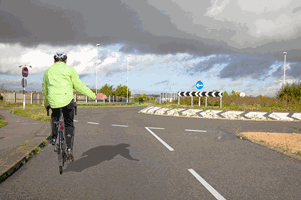
B
C
D
Correct Answer: C
Explanation: Cycling in today's heavy traffic can be hazardous. Some cyclists may not feel happy about crossing the path of traffic to take up a position in an outside lane. Be aware of this and understand that, although they're in the left-hand lane, the cyclist might be turning right.
Explanation: Cycling in today's heavy traffic can be hazardous. Some cyclists may not feel happy about crossing the path of traffic to take up a position in an outside lane. Be aware of this and understand that, although they're in the left-hand lane, the cyclist might be turning right.
Correct Answer: B
Explanation: Be courteous and prepare to stop. Don't wave people across, because this could be dangerous if another vehicle is approaching the crossing.
Explanation: Be courteous and prepare to stop. Don't wave people across, because this could be dangerous if another vehicle is approaching the crossing.
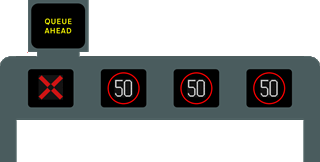
B
C
D
Correct Answer: D
Explanation: A red cross above the hard shoulder shows that it's closed as a running lane and should only be used for emergencies or breakdowns. On a smart motorway, the hard shoulder may be used as a running lane at busy times. This will be shown by a mandatory speed limit on the gantry above the hard shoulder.
Explanation: A red cross above the hard shoulder shows that it's closed as a running lane and should only be used for emergencies or breakdowns. On a smart motorway, the hard shoulder may be used as a running lane at busy times. This will be shown by a mandatory speed limit on the gantry above the hard shoulder.
33. A person has been injured. They may be suffering from shock. What are the warning signs to look for? Mark one answer
AB
C
D
Correct Answer: B
Explanation: The effects of shock may not be immediately obvious. Warning signs are rapid pulse, sweating, pale grey skin and rapid shallow breathing.
Explanation: The effects of shock may not be immediately obvious. Warning signs are rapid pulse, sweating, pale grey skin and rapid shallow breathing.
Correct Answer: C
Explanation: Be aware that this is just the braking distance. You need to add the thinking distance to this to give the overall stopping distance. At 50 mph, the typical thinking distance will be 15 metres (50 feet), plus a braking distance of 38 metres (125 feet), giving an overall stopping distance of 53 metres (175 feet). The stopping distance could be greater than this, depending on your attention and response to any hazards. These figures are a general guide.
Explanation: Be aware that this is just the braking distance. You need to add the thinking distance to this to give the overall stopping distance. At 50 mph, the typical thinking distance will be 15 metres (50 feet), plus a braking distance of 38 metres (125 feet), giving an overall stopping distance of 53 metres (175 feet). The stopping distance could be greater than this, depending on your attention and response to any hazards. These figures are a general guide.
Correct Answer: B
Explanation: Slow down and be ready to stop if you see animals in the road ahead. Animals are easily frightened by noise and vehicles passing too close to them. Stop if signalled to do so by the person in charge.
Explanation: Slow down and be ready to stop if you see animals in the road ahead. Animals are easily frightened by noise and vehicles passing too close to them. Stop if signalled to do so by the person in charge.
36. You're following other vehicles in fog. You have your lights on. What else can you do to reduce the chances of being in a collision? Mark one answer
AB
C
D
Correct Answer: C
Explanation: When it's foggy, use dipped headlights. This will help you see and be seen by other road users. If visibility is seriously reduced, consider using front and rear fog lights if you have them. Keep to a sensible speed and don't follow the vehicle in front too closely. If the road is wet and slippery, you'll need to allow twice the normal stopping distance.
Explanation: When it's foggy, use dipped headlights. This will help you see and be seen by other road users. If visibility is seriously reduced, consider using front and rear fog lights if you have them. Keep to a sensible speed and don't follow the vehicle in front too closely. If the road is wet and slippery, you'll need to allow twice the normal stopping distance.
Correct Answer: C
Explanation: If someone in charge of animals asks you to stop, you should do so and switch off your engine. Animals are unpredictable and startle easily; they could turn and run into your path or into the path of another moving vehicle.
Explanation: If someone in charge of animals asks you to stop, you should do so and switch off your engine. Animals are unpredictable and startle easily; they could turn and run into your path or into the path of another moving vehicle.
38. You want to reverse into a side road, but you aren't sure that the area behind your car is clear. What should you do? Mark one answer
AB
C
D
Correct Answer: C
Explanation: If you can't tell whether there's anything behind you, it's always safest to check before reversing. There may be a small child or a low obstruction close behind your car.
Explanation: If you can't tell whether there's anything behind you, it's always safest to check before reversing. There may be a small child or a low obstruction close behind your car.
39. You intend to turn left from a main road into a minor road. What should you do as you approach it? Mark one answer
AB
C
D
Correct Answer: C
Explanation: Your road position can help other road users to anticipate your actions. Keep to the left as you approach a left turn and don't swing out into the centre of the road in order to make the turn easier. This could endanger oncoming traffic and may cause other road users to misunderstand your intentions.
Explanation: Your road position can help other road users to anticipate your actions. Keep to the left as you approach a left turn and don't swing out into the centre of the road in order to make the turn easier. This could endanger oncoming traffic and may cause other road users to misunderstand your intentions.
40. What should you do when you're unsure whether it's safe to reverse your vehicle? Mark one answer
AB
C
D
Correct Answer: A
Explanation: A small child could be hidden directly behind you, so, if you can't see all around your vehicle, get out and have a look. You could also ask someone reliable outside the vehicle to guide you.
Explanation: A small child could be hidden directly behind you, so, if you can't see all around your vehicle, get out and have a look. You could also ask someone reliable outside the vehicle to guide you.
Correct Answer: B
Explanation: Don't reverse into a main road from a side road. The main road is likely to be busy and the traffic on it moving quickly.
Explanation: Don't reverse into a main road from a side road. The main road is likely to be busy and the traffic on it moving quickly.
Correct Answer: A
Explanation: If you have a garage, use it. Your vehicle is less likely to be a victim of car crime if it's in a garage. Also, in winter, the windows will be kept free from ice and snow.
Explanation: If you have a garage, use it. Your vehicle is less likely to be a victim of car crime if it's in a garage. Also, in winter, the windows will be kept free from ice and snow.
Correct Answer: B
Explanation: Emission tests are carried out to make sure your vehicle's engine is operating efficiently. This ensures the pollution produced by the engine is kept to a minimum. If your vehicle isn't serviced regularly, it may fail the annual MOT test.
Explanation: Emission tests are carried out to make sure your vehicle's engine is operating efficiently. This ensures the pollution produced by the engine is kept to a minimum. If your vehicle isn't serviced regularly, it may fail the annual MOT test.
Correct Answer: C
Explanation: If you have ABS and need to stop in an emergency, keep your foot firmly on the brake pedal until the vehicle has stopped. When the ABS operates, you may hear a grating sound and feel vibration through the brake pedal. This is normal and you should maintain pressure on the brake pedal until the vehicle stops.
Explanation: If you have ABS and need to stop in an emergency, keep your foot firmly on the brake pedal until the vehicle has stopped. When the ABS operates, you may hear a grating sound and feel vibration through the brake pedal. This is normal and you should maintain pressure on the brake pedal until the vehicle stops.
45. You're driving along this motorway. It's raining. What should you do when following this lorry? Mark one answer
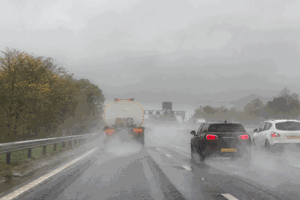
B
C
D
Correct Answer: B
Explanation: The usual two-second time gap increases to four seconds when the roads are wet. If you stay well back, you'll
- be able to see past the vehicle
- be out of the spray thrown up by the lorry's tyres
- give yourself more time to stop if the need arises
- increase your chances of being seen by the lorry driver
Explanation: The usual two-second time gap increases to four seconds when the roads are wet. If you stay well back, you'll
- be able to see past the vehicle
- be out of the spray thrown up by the lorry's tyres
- give yourself more time to stop if the need arises
- increase your chances of being seen by the lorry driver
Correct Answer: D
Explanation: Coasting is when you allow the vehicle to freewheel in neutral or with the clutch pedal depressed. Speed will increase as you lose the benefits of engine braking and have less control. You shouldn't coast, especially when approaching hazards such as junctions or bends and when travelling downhill.
Explanation: Coasting is when you allow the vehicle to freewheel in neutral or with the clutch pedal depressed. Speed will increase as you lose the benefits of engine braking and have less control. You shouldn't coast, especially when approaching hazards such as junctions or bends and when travelling downhill.
47. Your vehicle catches fire while driving through a tunnel. It's still driveable. What should you do? Mark one answer
AB
C
D
Correct Answer: A
Explanation: If it's possible, and you can do so without causing further danger, it may be safer to drive a vehicle that's on fire out of a tunnel. The greatest danger in a tunnel fire is smoke and suffocation.
Explanation: If it's possible, and you can do so without causing further danger, it may be safer to drive a vehicle that's on fire out of a tunnel. The greatest danger in a tunnel fire is smoke and suffocation.
48. After passing your driving test, you suffer from ill health. This affects your driving. What must you do? Mark one answer
AB
C
D
Correct Answer: C
Explanation: You must tell DVLA (or DVA in Northern Ireland) if your health is likely to affect your ability to drive. The licensing authority will investigate your situation and then make a decision on whether or not to take away your licence.
Explanation: You must tell DVLA (or DVA in Northern Ireland) if your health is likely to affect your ability to drive. The licensing authority will investigate your situation and then make a decision on whether or not to take away your licence.
Correct Answer: A
Explanation: Never stop on the hard shoulder to rest. If there's no service area for several miles, leave the motorway at the next exit and find somewhere safe and legal to pull over.
Explanation: Never stop on the hard shoulder to rest. If there's no service area for several miles, leave the motorway at the next exit and find somewhere safe and legal to pull over.
Correct Answer: C
Explanation: You should only stop on the hard shoulder in a genuine emergency. Don't stop there to have a rest or picnic, pick up hitchhikers, answer a mobile phone or check a map. If you miss your intended exit, carry on to the next. Never reverse along the hard shoulder.
Explanation: You should only stop on the hard shoulder in a genuine emergency. Don't stop there to have a rest or picnic, pick up hitchhikers, answer a mobile phone or check a map. If you miss your intended exit, carry on to the next. Never reverse along the hard shoulder.



